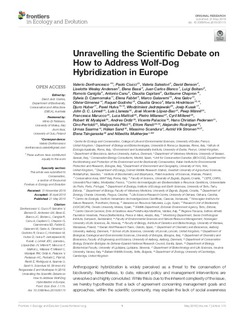Unravelling the Scientific Debate on How to Address Wolf-Dog Hybridization in Europe
| dc.contributor.author | Donfrancesco, Valerio | |
| dc.contributor.author | Ciucci, Paolo | |
| dc.contributor.author | Salvatori, Valeria | |
| dc.contributor.author | Benson, David J. | |
| dc.contributor.author | Andersen, Liselotte Wesley | |
| dc.contributor.author | Bassi, Elena | |
| dc.contributor.author | Blanco, Juan Carlos | |
| dc.contributor.author | Boitani, Luigi | |
| dc.contributor.author | Caniglia, Romolo | |
| dc.contributor.author | Canu, Antonio | |
| dc.contributor.author | Capitani, Claudia | |
| dc.contributor.author | Chapron, Guillaume | |
| dc.contributor.author | Czarnomska, Sylwia D. | |
| dc.contributor.author | Fabbri, Elena | |
| dc.contributor.author | Galaverni, Marco | |
| dc.contributor.author | Galov, Ana | |
| dc.contributor.author | Gimenez, Olivier | |
| dc.contributor.author | Godinho, Raquel | |
| dc.contributor.author | Greco, Claudia | |
| dc.contributor.author | Hindrikson, Maris | |
| dc.contributor.author | Huber, Djuro | |
| dc.contributor.author | Hulva, Pavel | |
| dc.contributor.author | Jedrzejewski, Włodzimierz | |
| dc.contributor.author | Kusak, Josip | |
| dc.contributor.author | Linnell, John Durrus | |
| dc.contributor.author | Llaneza, Luis | |
| dc.contributor.author | López-Bao, José Vicente | |
| dc.contributor.author | Männil, Peep | |
| dc.contributor.author | Marucco, Francesca | |
| dc.contributor.author | Mattioli, Luca | |
| dc.contributor.author | Milanesi, Pietro | |
| dc.contributor.author | Milleret, Cyril Pierre | |
| dc.contributor.author | Mysłajek, Robert W. | |
| dc.contributor.author | Ordiz, Andres | |
| dc.contributor.author | Palacios, Vicente | |
| dc.contributor.author | Pedersen, Hans Christian | |
| dc.contributor.author | Pertoldi, Cino | |
| dc.contributor.author | Pilot, Malgorzata | |
| dc.contributor.author | Randi, Ettore | |
| dc.contributor.author | Rodriguez, Alejandro | |
| dc.contributor.author | Saarma, Urmas | |
| dc.contributor.author | Sand, Håkan | |
| dc.contributor.author | Scandura, Massimo | |
| dc.contributor.author | Stronen, Astrid Vik | |
| dc.contributor.author | Tsingaraska, Elena | |
| dc.contributor.author | Mukherjee, Nibedita | |
| dc.date.accessioned | 2019-12-03T10:10:52Z | |
| dc.date.available | 2019-12-03T10:10:52Z | |
| dc.date.created | 2019-05-21T13:11:47Z | |
| dc.date.issued | 2019 | |
| dc.identifier.issn | 2296-701X | |
| dc.identifier.uri | http://hdl.handle.net/11250/2631443 | |
| dc.description.abstract | Anthropogenic hybridization is widely perceived as a threat to the conservation of biodiversity. Nevertheless, to date, relevant policy and management interventions are unresolved and highly convoluted. While this is due to the inherent complexity of the issue, we hereby hypothesize that a lack of agreement concerning management goals and approaches, within the scientific community, may explain the lack of social awarenesson this phenomenon, and the absence of effective pressure on decision-makers. By focusing on wolf x dog hybridization in Europe, we hereby (a) assess the state of the art of issues on wolf x dog hybridization within the scientific community, (b) assess the conceptual bases for different viewpoints, and (c) provide a conceptual framework aiming at reducing the disagreements.We adopted the Delphi technique, involving a three-round iterative survey addressed to a selected sample of experts who published at Web of Science listed journals, in the last 10 years on wolf x dog hybridization and related topics. Consensus was reached that admixed individuals should always be defined according to their genetic profile, and that a reference threshold for admixture (i.e., q-value in assignment tests) should be formally adopted for their identification. Tomitigate hybridization, experts agreed on adopting preventive, proactive and, when concerning small and recovering wolf populations, reactive interventions. Overall, experts’ consensus waned as the issues addressed became increasingly practical, including the adoption of lethal removal. We suggest three non-mutually exclusive explanations for this trend: (i) value-laden viewpoints increasingly emerge when addressing practical issues, and are particularly diverging between experts with different disciplinary backgrounds (e.g., ecologists, geneticists); (ii) some experts prefer avoiding the risk of potentially giving carte blanche to wolf opponents to (illegally) remove wolves, based on the wolf x dog hybridization issue; (iii) room for subjective interpretation and opinions result from the paucity of data on the effectiveness of different management interventions. These results have management implications and reveal gaps in the knowledge on a wide Spectrum of issues related not only to the management of anthropogenic hybridization, but also to the role of ethical values and real-world management concerns in the scientific debate. conservation, delphi technique, genetic admixture, introgression, lethal removal, management, ethics, values in science | nb_NO |
| dc.language.iso | eng | nb_NO |
| dc.title | Unravelling the Scientific Debate on How to Address Wolf-Dog Hybridization in Europe | nb_NO |
| dc.type | Journal article | nb_NO |
| dc.type | Peer reviewed | nb_NO |
| dc.description.version | publishedVersion | nb_NO |
| dc.source.volume | 7 | nb_NO |
| dc.source.journal | Frontiers in Ecology and Evolution | nb_NO |
| dc.identifier.doi | 10.3389/fevo.2019.00175 | |
| dc.identifier.cristin | 1699134 | |
| dc.relation.project | Norges forskningsråd: 251112 | nb_NO |
| cristin.unitcode | 192,14,0,0 | |
| cristin.unitname | Miljøvitenskap og naturforvaltning | |
| cristin.ispublished | true | |
| cristin.fulltext | original | |
| cristin.qualitycode | 1 |
